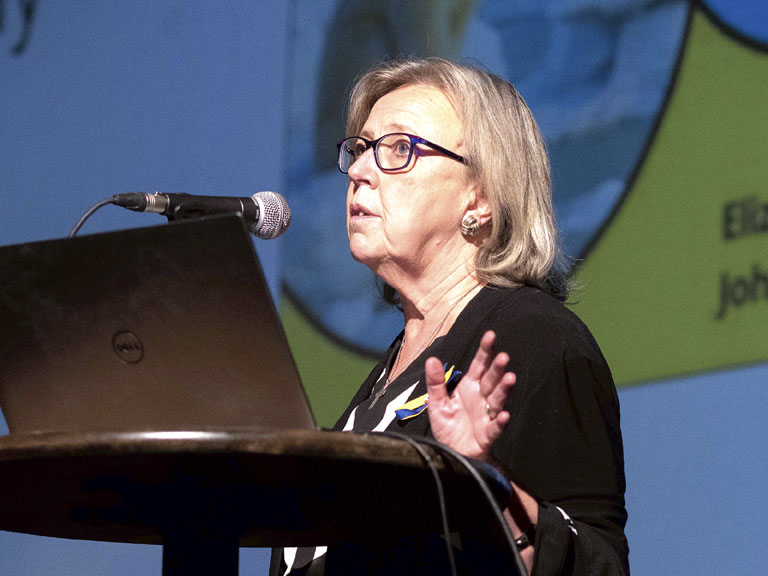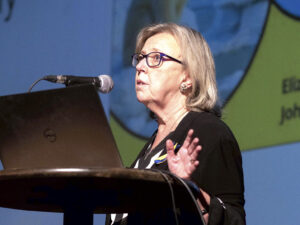County News
Greening our County

Inaugural climate event at the Regent Theatre
The County’s Environmental Advisory Committee (EAC) held its inaugural Greening Our County event at the Regent Theatre last Sunday. The event was intended to raise awareness of the current and growing climate crisis and illuminate some actions that residents of the County could take to reduce their carbon footprint while at the same time improving the biodiversity of this area. The keynote speaker for the event was Member of Parliament Elizabeth May. The session started with an introduction by Mayor Steve Ferguson. He began with the County’s land acknowledgement, which pledges continued stewardship of the land. “Stewardship can be defined as the careful and responsible management of something entrusted to one’s care, and care of the environment certainly falls into that context,” he said. He went on to thank the EAC for their work and explained to those in attendance that the role of the committee was to help Council make decisions that incorporate the best environmental practises. He noted that the committee’s term ends with the current term of council and expressed his wish that the current members would volunteer to continue their work in the new term of council. Youth activist and former Hasting Prince Edward School Board Indigenous Student Trustee Moira Gaddes then recited the traditional Indigenous welcome address, the Ohenten Kariwatekwen, to formally open the Land Stewardship session, moderated by EAC chair Jane Lesslie.
Sheila Kuja started the session by describing the biodiversity of the County and the areas where it is under threat. She noted there are five primary threats to biodiversity loss, all associated with human activities: habitat loss, invasive species, overexploitation, and climate change associated with global warming. She said the County’s geographic location gives it a large biodiversity potential. It is home to southern species as well as northern species, and remains a home to a number of species that are endangered or threatened elsewhere in the province. It is also home to a natural corridor for migrating birds, with close to 300 species being recorded, including large numbers of owls and raptors. The County is also home to several endangered species and threatened habitat, including the oak-hickory woodland, which at one time covered about 20 per cent of the County and of which there are now only small pockets left. At the end of her presentation she listed a number of ways that County residents can help to protect this area’s biodiversity, including joining one or more of the various nature or conservation groups.
Author Lorraine Johnson then spoke about ways to restore pollinator habitat and increase climate resilience and biodiversity by making simple changes to lawns and gardens. She noted that a monoculture, such as a lawn, is environmentally vulnerable, whereas a garden planted with many different species is much more resilient. Of particular interest are the reintroduction of native plants, many of which have a co-evolved dependency on insect and butterfly species. Restoring a variety of plants will bring in the insects that depend on them, and that will encourage bird species, creating the building blocks to build a web of biodiversity. The next presenter, Jennifer Gagné, spoke about the County’s tree management and preservation policy. Currently, this policy applies only on municipally- owned land or on certain private lands under the purview of the Planning Act. She noted there are two main ways to preserve or increase the tree cover in the County. The first is by protecting mature trees—ensuring that new building projects save as many trees as possible, and by limiting construction near trees. The second avenue is by planting more trees, with an eye to species diversity and the goal of having the right tree in the right place.

Green MP Elizabeth May speaks about climate change and the abrupt rise of atmospheric carbon dioxide levels during her lifetime.
Following a brief intermission, MP Elizabeth May gave a presentation on the “big picture” of climate change. She has been an environmental activist for decades, concerned with issues like acid rain and the loss of the ozone layer. “I’ve worked on climate change before it became obvious that it was happening,” she said. That began in the early 1980s, when the predictions of the day was that if nothing were done, the earth’s glaciers would be receding in the 2030s. “We always underestimate how much damage we are doing, and we always overestimate how much time we have,” she said. She explained that for all but the last 200 years of human history, the carbon dioxide level in the atmosphere was a bit less than 300 parts per million (ppm). Without that level of CO2, the earth would be too cold to support life, since CO2 helps to trap heat in the atmosphere. In the 1940s, the portion of CO2 had risen to 313 ppm; it is now at 419 ppm. “We have emitted more greenhouse gases to the atmosphere between 1992 and now than we had done since the beginning of the Industrial Revolution to 1992,” she said. “We have been committing ecocide and knowing it, but pretending everything was fine.”
May said that we have to become more radical and hold our governments to account if we are to make a difference. “It is not too late. We have every opportunity to stop the climate crisis from reaching its worst-case scenario. That means we have to stop our government from doing the wrong things. We don’t have time anymore for anything less than the truth, and the truth is actually good news. We can stop the climate crisis from ending human civilization. We can adapt. We can protect each other. We could still be, as a country, an example to the world to be the first to say really clearly ‘We’re ending oil now, and we are setting the future.’ By 2025 the electricity grid is 100 per cent renewable, by 2030 we’re not producing bitumen anymore. Those are doable things. What on earth can stop us from saving the lives of our own children? What would ever make us think it was too hard? It’s all really doable.”
The afternoon session ended with a presentation by Matt Bulley and Cedric Pepelea on existing and developing technologies to eliminate the use of fossil fuels for home heating and air conditioning. Heat pump technology can now provide warmth from outside air as cold as -30C, and during typical use, about 4 kilowatthours (kWh) of heat can be obtained for each kWh of electricity consumption, leading to longterm savings in energy use. The systems are currently expensive, and more suited to new builds, but loans and grants are available to lessen the financial burden.

Comments (0)